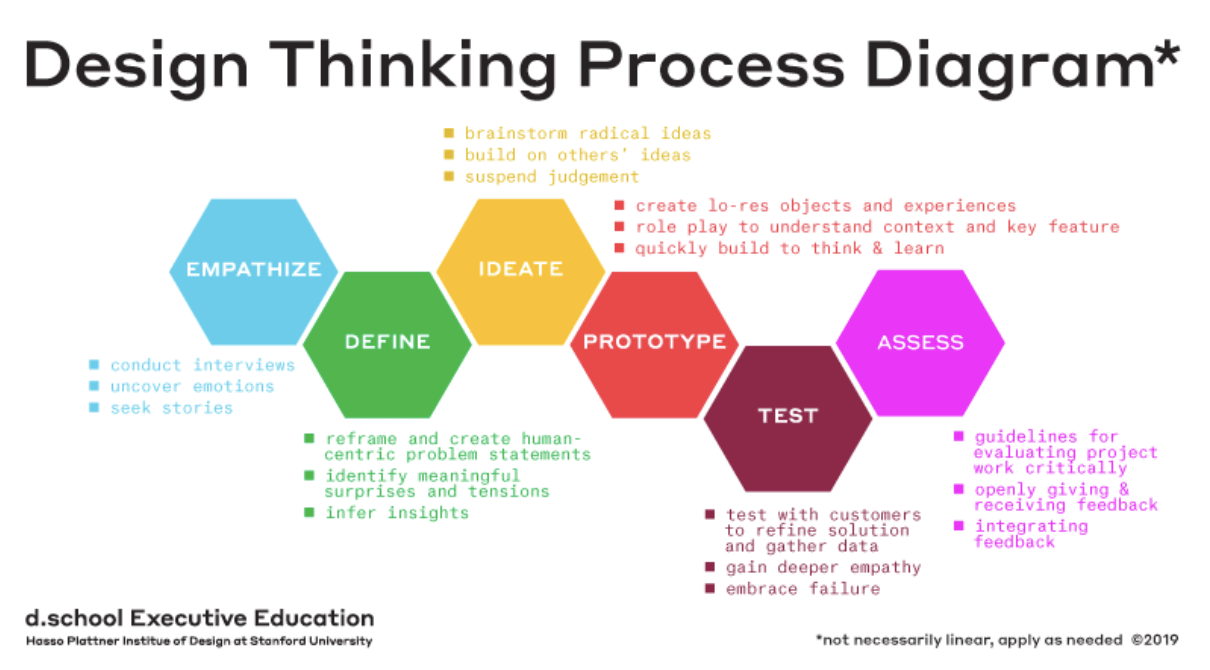Design Thinking
What It Is
Design thinking (DT) is an iterative, human-centered, creative approach to innovation that integrates the needs of people, and what is feasible, equitable, and sustainable (IDEO, 2022). Teaching uses design thinking to keep improving practice of attaining the goal of student learning. Therefore, design thinking from a teaching and learning perspective views teachers as designers.

Why It Matters
Learners need critical, creative, and collaborative skills to address society’s increasingly complex and difficult challenges such as climate change, poverty, housing instability, and health promotion (McLaughlin et al., 2022). Design thinking provides an opportunity to equip students with the critical, creative, and collaborative skills because of its application in designing learning tasks within higher education (Kalantzis & Cope, 2010; McLaughlin et al., 2022).
Apply it
Instructors can apply design thinking by focusing on the elements that are most important to the design of effective learning tasks and processes (Bower, 2017). Wrigley and Straker’s (2017) Educational Design Ladder offers an organizational approach to integrating DT in teaching. They recommend aligning learning modes and assessments across 5 stages.
- – Factual – Learning modes include lectures, tutorials, discussions and other introductory activities. Assessment approaches focus on analysis of design processes or reflection.
- – Conceptual product content design – Learning modes include collaborative design projects, workshops, and field study. Assessment approaches focus on written or verbal design discussions and individual design assignments.
- – Conceptual design management – Learning modes include identifying and assessing design methods and processes. Assessment approaches can include more formalized processes such as research, project design, or experimentation.
- – Procedural – Learning modes include synthesizing design procedures and constructing forward-looking strategies. Assessment strategies include idea pitches, business plans, and formalized writing.
- – Metacognitive – Learning modes include development and demonstration of workplace or applied skills and methods for opportunity discovery. Assessment strategies include collaborative work and applied problem solving.
Resources
- – Explore: Design Thinking Your Teaching
- – Read: Building Your Course Around Design Principles
- – Explore: Design Thinking Defined
- – Read: Design Thinking in Higher Education
References
Bower, M. (2017). Design of technology-enhanced learning. Bingley: Emerald Publishing Limited.
Kalantzis, M., & Cope, B. (2010). The teacher as designer: Pedagogy in the new media age. E-Learning and Digital Media, 7(3), 200–222. https://doi.org/10.2304/elea.2010.7.3.200
McLaughlin, J. E., Chen, E., Lake, D., Guo, W., Skywark, E. R., Chernik, A., & Liu, T. (2022). Design thinking teaching and learning in higher education: Experiences across four universities. PLoS ONE, 17(3), 1–16. https://doi.org/10.1371/journal.pone.0265902
Wrigley, C., & Straker, K. (2017). Design thinking pedagogy: The educational design ladder. Innovations in Education and Teaching International, 54(4), 374-385.
Cite This Resource
Studio for Teaching & Learning Innovation. (2023, January). Design thinking [Teaching resource]. https://stli.wm.edu/design-thinking/
Updated 2/2023